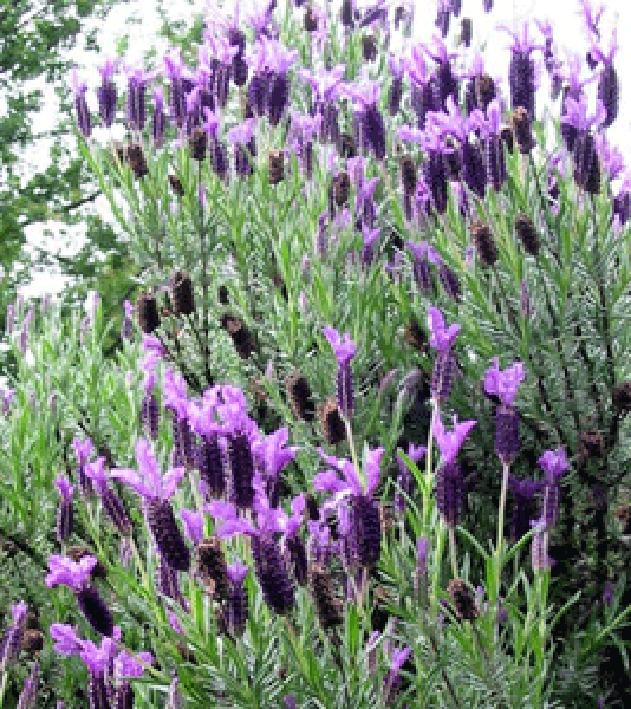 Flowering lavender
Lavandula
angustifolia
plant.
Flowering lavender
Lavandula
angustifolia
plant.
Welcome to the summary page for FabulousFusionFood's Herb guide to Lavender along with all the Lavender containing recipes presented on this site, with 19 recipes in total.
e This is a continuation of an entire series of pages that will, I hope, allow my visitors to better navigate this site. As well as displaying recipes by name, country and region of origin I am now planning a whole series of pages where recipes can be located by meal type and main ingredient. This page gives a listing of all the Cornish recipes added to this site.
These recipes, all contain Lavender as a major herb flavouring.
Lavenders (Lavandula) are a genus of about 30 species of flowering plants in the Lamiaceae (mint) family. They are native from the Mediterranean region south to tropical Africa and to the south east regions of India. The name is derived from Latin lavare 'to wash', referring to lavender's use in bath essences.
Lavender flowers have a strong, highly perfumed odour and a bitter overtone. The essential oil of the leaves (present at a level of 1 to 3%) is rich in linalyl acetate (30 to 55%) and linalool (20 to 35%). Other aromatic compounds include β-ocimene, cineol, camphor and caryophyllene epoxide as well as coumarin derivatives (coumarin, dihydrocoumarin, herniarin, umbelliferone), which are present at very low concentrations.
The most common cultivar is Lavandula angustifolia (formerly L officinalis) and it is this that's used as a herb. It must be admitted that lavender is not a common herb but it is characteristic of the cuisine of Provence in Southern France where it can be a component of Herbes de Provence along with chervil, tarragon, savory, marjoram, rosemary, thyme and sometimes fennel. This mixture is used for many dishes of the region, especially fish, but also meat and vegetables; a famous example is ratatouille, a flavourful vegetable stew made of courgette [zucchini] (or squash), tomatoes and aubergines.
Lavender should only be used sparingly as it is a very robust spice. Also note that lavender is a potent allergen and should not be consumed if pregnant or breast-feeding. Cookbooks suggest lavender for meat (mutton with its strong flavour is an obvious choice) and it can also be used as an ingredient in oil and vinegar based dressings and can be added as a flavouring for desserts in place of vanilla.
e This is a continuation of an entire series of pages that will, I hope, allow my visitors to better navigate this site. As well as displaying recipes by name, country and region of origin I am now planning a whole series of pages where recipes can be located by meal type and main ingredient. This page gives a listing of all the Cornish recipes added to this site.
These recipes, all contain Lavender as a major herb flavouring.
Lavenders (Lavandula) are a genus of about 30 species of flowering plants in the Lamiaceae (mint) family. They are native from the Mediterranean region south to tropical Africa and to the south east regions of India. The name is derived from Latin lavare 'to wash', referring to lavender's use in bath essences.
Lavender flowers have a strong, highly perfumed odour and a bitter overtone. The essential oil of the leaves (present at a level of 1 to 3%) is rich in linalyl acetate (30 to 55%) and linalool (20 to 35%). Other aromatic compounds include β-ocimene, cineol, camphor and caryophyllene epoxide as well as coumarin derivatives (coumarin, dihydrocoumarin, herniarin, umbelliferone), which are present at very low concentrations.
The most common cultivar is Lavandula angustifolia (formerly L officinalis) and it is this that's used as a herb. It must be admitted that lavender is not a common herb but it is characteristic of the cuisine of Provence in Southern France where it can be a component of Herbes de Provence along with chervil, tarragon, savory, marjoram, rosemary, thyme and sometimes fennel. This mixture is used for many dishes of the region, especially fish, but also meat and vegetables; a famous example is ratatouille, a flavourful vegetable stew made of courgette [zucchini] (or squash), tomatoes and aubergines.
Lavender should only be used sparingly as it is a very robust spice. Also note that lavender is a potent allergen and should not be consumed if pregnant or breast-feeding. Cookbooks suggest lavender for meat (mutton with its strong flavour is an obvious choice) and it can also be used as an ingredient in oil and vinegar based dressings and can be added as a flavouring for desserts in place of vanilla.
The alphabetical list of all Lavender recipes on this site follows, (limited to 100 recipes per page). There are 19 recipes in total:
Page 1 of 1
| Almond and Lavender Biscuits Origin: Britain | Lavender Focaccia Origin: Britain | Le Galapian Origin: Monaco |
| Apple and Lavender Jelly Origin: Britain | Lavender Harvest Fudge Origin: Britain | Ras el hanout Origin: North Africa |
| Blossoms of Health Tea Origin: American | Lavender Icing Origin: American | Roast Venison with Elderberries and Lavender Vinegar Origin: Britain |
| Heather and Lavender Shortbread Origin: Ireland | Lavender Lemonade Origin: American | Sugared Flower Shortbreads Origin: Britain |
| Herbes de Provence Origin: France | Lavender Tea Biscuits Origin: American | Valerian Hot Chocolate Origin: Britain |
| Lavender Chocolate Chip Cookies Origin: Britain | Lavender Vinegar Origin: American | |
| Lavender Crème Brulée Origin: France | Lavender Vinegar II Origin: Britain |
Page 1 of 1